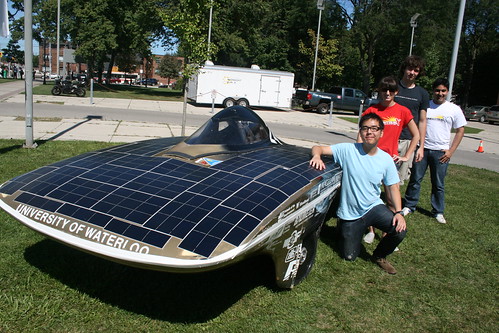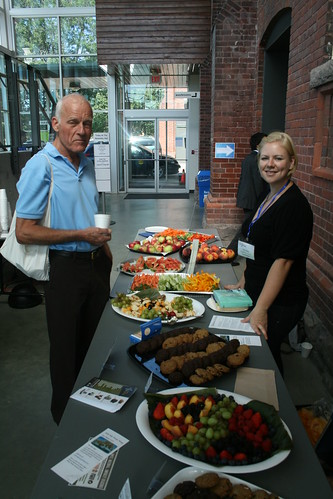Introduction
Energy has become a hot topic during the Province of Ontario’s 40th election campaign. Hydro bills, the smart grid (read: time-of-use pricing) and the energy fuel mix are all issues that have animated the policy positions of the four main parties as voters prepare to head to the polls on October 6, 2011. The debate surrounding the province’s renewable energy sector has created uncertainty about the future of the
Green Energy and Green Economy Act (Ontario) and the
Feed-in-Tariff programs. Proponents have hailed these regulatory features as world-class achievements, while others have criticized them as unfair and expensive subsidies.
In the two years of the FIT programs, Ontario has made significant progress. The province has
over 90 projects operational with a nameplate capacity of over 24MW. By comparison, it takes on average of 60 months to construct a nuclear plant, from pouring the first concrete to putting power on the grid. This does not include the time needed to plan; complete environmental assessments and public consultations; obtain permits and licenses; or design, manufacture and finance it. These activities all add to the time before a nuclear plant will turn on a single light bulb.
The Parties Speak
One of the more recent high profile attempts to understand the panoply of policy choices facing Ontario’s voters was a gathering of the key energy representatives of each major political party on TVO’s The Agenda with Steve Paikin. On September 7, 2011, Paikin’s episode
The Debate: Energy and the Ontario Election featured Ontario Energy Minister
Brad Duguid, PC Energy Critic
John Yakabuski, NDP Energy Critic
Peter Tabuns, Ontario Green Party Candidate
Steve Dyck, and energy analyst Steve Aplin.
Just as helpfully, the
Ontario Sustainable Energy Association took the month of August to put together a similar roster of party representatives (only switching out Dyck with GPO Leader
Mike Schreiner) to address issues such as renewable energy, conservation and community power more specifically. In a
series of one-on-one web interviews, OSEA Executive Director Kris Stevens asked each party about their positions on the preceding issues.
Blackout – The Conservatives Remain Mum
Unfortunately, after interviewing Duguid, Tabuns and Schreiner, Stevens was forced into sending out a public letter to the OSEA community announcing that Conservative energy critic John Yakubuski had withdrawn from participating in the interviews. Stevens explained that Yakabuski’s office had indicated several months ago that Yakabuski would participate in a session. However, after weeks of delays, further promises of participation, offers on Steven’s behalf to travel to the riding of Renfrew-Nipissing to interview Yakabuski and a variety of other efforts, the Conservative candidate cancelled his participation. As Stevens' put it:
Silence sometimes speaks louder than words. We are left to assume that the Conservative party has no plan for conservation, community-based renewables, the private sector or manufacturing beyond killing what has been heralded as the most progressive energy policy in North America.
It is with deep gratitude that this blog can post the work of OSEA volunteer (and occasional Wakulat|Law guest blogger) Neil Fairhead who put together and shared the following summary of the three parties who participated in the OSEA interview process. The party positions appear in alphabetic order: Green Party, Liberal Party, and NDP.
Green Party - Conservation, Efficiency and Community
Mike Schreiner, Party Leader, laid out an approach to energy for Ontario that places an emphasis on efficiency, conservation and the involvement of local communities.
Schreiner stated “no more investment in nuclear” since the average overrun on nuclear projects has been five times the original budget. This money would be better spent on conservation where half the cost would save the same amount of power and create nine times the jobs - retrofitting current housing, insulation and providing solar thermal heating of domestic water.
He also emphasized the need to get much closer community involvement. In particular, the benefits of renewable power must be shared locally. In Germany, over 200,000 people have equity stakes in local projects. This local involvement is essential to balancing the interest of local communities with the broader needs of the whole province. To achieve this, the Green Party will ensure community access to capital and priority access to the grid. They will also focus on energy education, for both consumers and workers.
The Green Party's priorities are:
- A programme on energy efficiency and conservation - “Reduced bills, same lifestyle”.
- Revise the FIT process, focusing on communities so they invest more and they benefit more - financially with revenue and economically with jobs.
- A new long-term energy plan with a broader supply mix including more combined heat-and-power, renewables and hydro - from Quebec and Manitoba as well as Ontario. The plan would include a budget so that businesses can invest in Ontario knowing they will have reliable, affordable energy.
Liberal Party - Green Energy Is Good for Ontario and for Ontarians
Minister Duguid, outlined a vision of Ontario based on four pillars:
- A healthier environment for children as coal burning power stations are phased out;
- A healthier electricity system that has not suffered brownouts nor blackouts nor needed large imports of high priced power this year - despite the record heat wave;
- A healthy job market that has already bounced back from the recession, thanks in large part to 20,000 new jobs in clean energy - the rest of the economy remains fragile;
- A healthier climate for investment - $20 billion have already been invested in the new green economy in Ontario.
The Liberal Party believes that it must balance the need to invest in the Province's ageing transmission and generation infrastructure, with the need to help households by minimizing rates such as the current 10% green energy rebate. Investing in conservation also helps households since the cheapest watt is the one we do not use. The Liberal Government has doubled the expenditure of its predecessor and believes this must continue as there are key improvements required to ensure a reliable, efficient and non-polluting supply of energy. These investments include more storage, a more flexible grid and meters that encourage ratepayers to use electricity when there is spare capacity and to reduce their usage at times of high demand.
The Liberals recognize that some changes are required and Duguid specifically highlighted the role of municipalities: “Municipal engagement is mandatory and, while the government is working to streamline the process, it will remain mandatory.” He also highlighted the value of using the same energy for both power generation and for heating through the use of combined heat-and-power plants. Finally he stated that the price paid for electricity from renewable sources will have to come down and that they are looking at price reduction milestones. However, he noted that the costs of production, such as solar panels, are already coming down which will enable the price reductions while still rewarding investment. The research going on in Ontario will help to drive the costs down further.
In short, the Liberal Party believes that their commitment to green energy has been good for Ontario and we should persist with it - to provide a cleaner, more healthy environment for our children and a more prosperous, clean energy based, economy.
NDP - Waste Not Want Not
Energy Critic Tabuns started with three key points:
- The province's current approach places too little emphasis on efficiency and conservation;
- Nuclear power consistently goes over budget creating large cost overruns to be paid by the taxpayer or the customer. The current assumption that nuclear remains the source of half of our power needs to change.
- The partial privatization of our electricity system has resulted in “hundreds of millions of dollars being paid to energy traders and producers who game the system.”
The NDP put much greater emphasis on efficiency and conservation. They stand for minimizing usage through less waste and greater efficiency; and then supplying much of what is needed via renewables. There are challenges in doing this. Our 20th century system is highly centralized: big nuclear plants, coal plants, hydro plants - and networks that move power outwards. The 21st century system is more dispersed. We need a distribution system to match if we want to keep up with the leaders. Ontario has rested on investments made in the 20th century such as at Niagara Falls. Now we need to invest for this century but new/renovated generation capacity is high cost compared to increasing efficiency and conservation. We need to do both together to deliver the affordable reliable power, which will create the political support needed to make this change. The energy system is a major determinant of income and productivity in Ontario. If we fall behind it will be difficult to catch up.
The NDP energy platform for the upcoming election has two main thrusts:
- Conservation: avoid waste with increased efficiency to make the best use of the power consumed. This includes focusing on energy retrofits of buildings where much energy is wasted and on the Energy Star programme, improving the efficiency of appliances, etc.
- A balanced approach to energy supply: the environment must benefit and so must the economy with all sources rigorously assessed for costs and benefits. Given the disaster at Fukushima, nuclear costs will increase as more safety factors are addressed. The NDP will not rebuild the Darlington nuclear plant, using the funds saved elsewhere including retrofitting housing. Green energy will grow in significance but only where the costs and benefits justify it.
Conclusion
The future of Ontario’s energy policy is at stake in this election. In the last few years, the province has become home to some of the most exciting clean energy projects in the world, like the world's largest solar photovoltaic farm in Sarnia and Canada's largest rooftop solar installation in Windsor. Ten wind turbines in 2003 have sprouted to more than 900 turbines and counting. And people who used to work at automotive plants are now building these solar panels and turbines.
While the PC Party is not making its energy policies as accessible to voters as the other parties, it is reasonable to conclude its approach would diverge significantly from support of the
Green Energy and Green Economy Act. Their approach could kill some of these new energy jobs, stall innovation and increase dependence on dirty energy sources that contribute to asthma, lung disease and premature deaths.
Building an innovative economy for the 21st century requires risk-taking and comprehensive planning. Doing so effectively will enable Ontario to be a major international player in the trillion-dollar clean energy industry blowing around the world.

+v2.jpg)









